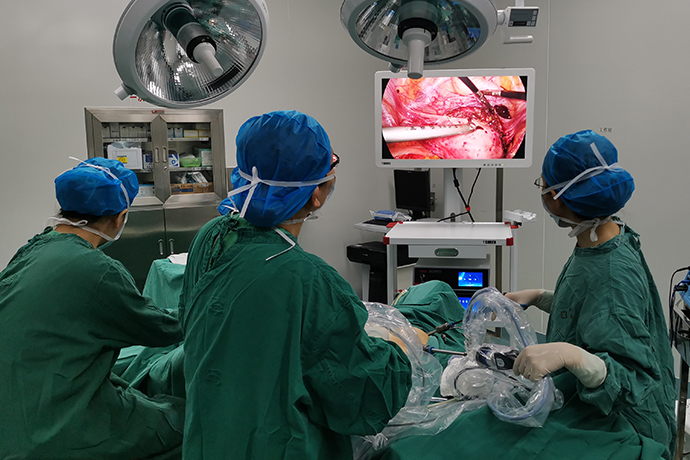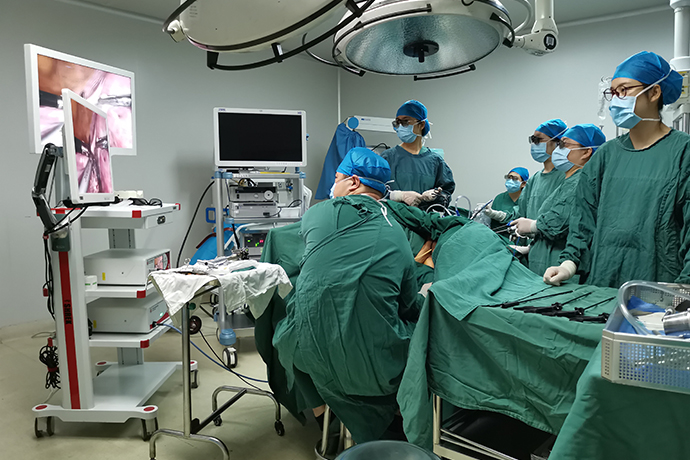[Gynecological Laparoscopy] 4K Laparoscopic Hysterectomy
Release time: 11 Jul 2023 Author:Shrek
The role of the uterus
Everyone should be clear about the three major functions of the uterus:
1. Menstrual cramps, the source of periodic endometrial exfoliation
2. The place where the fetus is conceived
3. Maintain the overall function and stability of the pelvic floor.

Since the significance of the uterus is so great, in what situations does hysterectomy have to be performed?
1. Multiple uterine fibroids, adenomyosis and other benign diseases
2. Endometrial cancer, uterine sarcoma, cervical cancer, ovarian cancer and other malignant tumors
3. Uterine malformation and other reproductive organ deformities cannot be repaired or perform the above functions but cause symptoms such as hemorrhage and pain
4. Severe uterine prolapse, which is ineffective after conservative treatment.
Hysterectomy procedure
Step 1: Coagulation and sectioning of the round ligament
Step 2: Opening of the anterior peritoneum of the broad ligament
Step 3: Broad ligament fenestration
Step 4: Bipolar Control of Accessory Vessels
Step 5: Retroperitoneal Dissection
Step 6: Vesicovaginal Dissection
Step 7: Uterine Vascular Dissection and Coagulation
Step 8: Vaginal Opening
Step 9: Uterine Extraction + Crush
Step 10: Vaginal Closure
Surgical technique
Anatomical issues: Hysterectomy mainly involves four ligaments and one major blood vessel (round ligament, ligament proper of the ovary, cardinal ligament, sacroligament and ascending branch of the uterine artery).
Most people have no problem with ligament rupture. The technical difficulty is mainly in the treatment of the ascending branch of the uterine artery. If this area is not handled properly, the urinary catheter will be damaged. What gynecologists are most afraid of is the "flowing water under the bridge" urine. Tube.
The division of the round ligament, ovarian proper ligament and sacroiliac ligament is relatively simple, because this place does not involve other organs and blood vessels, and there are basically no blood vessels in the ligament. Even if there are, the low-frequency mode of the ultrasonic scalpel can be easily severed without bleeding.
Of course, you can also choose scissors disconnection after bipolar coagulation. Before the main ligament is severed, the ascending branch of the uterine artery must be dealt with. If you want to deal with this place well, you can’t do it like a laparotomy, because the instruments used are different. The laparotomy uses suturing, while the laparoscopy uses an energy platform. Instruments, there is a problem of heat damage.
The size of the heat transfer is proportional to the heat transfer coefficient and the heat transfer area, and inversely proportional to the distance. Knowing this, you will know: the thermal conductivity of laparoscopic resection tissue is basically constant, and the amount of heat depends on the size of the tissue clamped by your energy instrument.
Therefore, laparoscopic surgery pays attention to slow work and careful work, and must not be used to save time. It should be separated layer by layer like peeling an onion, using each gap to fully bare the blood vessels.
After the uterine blood vessels are fully exposed, the main ligament will not bleed, and if there is no bleeding, there will be no damage caused by remediation after bleeding. Therefore, bleeding and damage are basically a pair of brothers and sisters, and they basically occur at the same time.
Surgical techniques and skills: The technique is not only the basic skills of incision, suture, ligation, and hemostasis, but also includes the use of energy instruments.
Now we have a lot of surgical weapons, such as monopolar, bipolar, ultrasonic scalpel, 100g forceps, Ligarsure, which parts are suitable for these weapons, and what are their advantages and disadvantages, we must be well aware, just like me above As for the problem of thermal damage, although the ultrasonic scalpel relies on the conversion of electrical energy into mechanical energy, the vibration and friction can cut and coagulate blood vessels, but the heat generated by its ultra-high frequency vibration and friction cannot be ignored.
Its working temperature is lower than that of single and double poles, only about 80 degrees. However, after stopping work, the temperature of the cutter head can last at 60 to 80 degrees for up to 45 seconds, which is far more than that of single and double poles. time of day.
If the ultrasonic scalpel touches sensitive tissues and organs such as the small intestine and ureter before it cools down, hidden damage that cannot be detected during the operation may occur. The use of bipolar also has its place to pay attention to.
Everyone has eaten roasted sweet potatoes, but you may not know that if you eat roasted sweet potatoes that are burnt on the outside and tender on the inside, it must be roasted on a high fire. The same is true for the use of bipolar. The phenomenon of tenderness in the skin will still cause bleeding when it is severed.
The temperature when sparks are generated by unipolar electrocoagulation tissue can reach 800 degrees, which is very easy to cause thermal damage. Ligarsue, on the other hand, can coagulate blood vessels up to 7 mm with minimal thermal diffusion, with only 1-2 mm of lateral heat conduction.
Surgical skills need to be continuously summarized and learned from the operations of big names, so as to be used by oneself. The skill of total laparoscopic hysterectomy is mainly the skill of vascular treatment.
There are mainly two parts:
One is to cut off the three tissues connecting the uterine horn: round ligament, fallopian tube, and proper ligament of ovary. I also said before that these parts are not rich in blood vessels and will not cause a lot of bleeding, but why do I emphasize that the treatment of this part is very important, because many people like to cut these three tissues close to the uterus. It is easier to cause damage to the ascending branch of the uterine artery on both sides of the uterus.
Once damaged, it takes time to stop bleeding and repair, and even cause damage to other tissues and organs again, so the operation cannot be fast or perfect. We try to choose a position 2 to 3 centimeters away from the side wall of the uterus to treat these three tissues, which can significantly reduce bleeding and post-bleeding damage.
The other part is the treatment of the ascending branch of the uterine artery: this part needs to be well cooperated by the person who lifts the uterus. The purpose of lifting the uterus is to achieve the effect of two large curved forceps clamped on the uterine corner like a laparotomy. One is to change the direction. , exposing the part to be operated, another very important function is traction and lifting, which is to create tension in the tissue of the operation site, so that some gaps can be fully exposed, and some original tissues and organs can be separated from the original The anatomical position is convenient for us to operate.
This mainly refers to the fact that after the lifting cup is pushed flat to the patient's head side, a certain safe distance will be formed between the uterine artery and the ureter. At this time, it will be very safe to electrocoagulate and disconnect the blood vessel on the upper edge of the lifting cup. . When dealing with uterine vessels, we try to deal with the right uterine vessels first and then the left, because the right ureter is farther away from the parauterine than the left.
What are the effects of hysterectomy?
At present, it is believed that the impact of hysterectomy on the body has both positive and negative aspects. On the one hand, patients relieve the pain of their original diseases after surgery, and have obvious improvements in health status and sexual life quality. , Hysterectomy does change the patient's normal anatomical structure, and has a greater psychological impact on some patients who have no medical knowledge. Patients who have undergone total hysterectomy may have psychological concerns that lead to a decline in their sexual function. Relevant studies have also shown that patients after hysterectomy may have different degrees of sexual dysfunction, but the occurrence of this situation is affected by many factors, the most important of which is psychological factors, that is, psychogenic factors. sexual dysfunction.
Why not worry too much about not having a uterus?
After the uterus completes the reproductive function, it is the overall function of menstrual cramps and pelvic floor stability. If the uterus must be removed due to disease, the latter two functions will not affect women's life and health. The ovaries are mainly preserved. Despite the hysterectomy, the ovarian function can still maintain the secondary sexual characteristics of women through the secretion of hormones, so the femininity remains. To some extent, maintaining femininity is more important than ovarian function. After hysterectomy, many women feel that they are incomplete. In fact, there is no need to be so anxious and depressed. Hysterectomy is for health purposes. If a woman has a vagina, her sex life will not change much; if her ovaries exist, her endocrine function remains the same, and her inner and outer appearance remain the same. Therefore, psychological adjustment before and after surgery is also very important. For women who have had their uterus removed, it is generally recommended that they avoid actions that increase abdominal pressure within six months after the operation, and at the same time it is not advisable to stand or sit for a long time. If after the resection, you find that the body suddenly has an abnormal condition of lower abdominal pain, you should go to a regular medical institution for diagnosis and treatment in time. As long as the patient recovers well after the operation, their normal sex life will not be affected at this time, and everyone can still go to work and do light physical activities, so there is no need to worry too much.

- Recommended news
- 【General Surgery Laparoscopy】Cholecystectomy
- Surgery Steps of Hysteroscopy for Intrauterine Adhesion
- [Gynecological Hysteroscopy] Techniques for Preventing and Treating Complications of Hysteroscopic Surgery
- [Gynecological Hysteroscopy] Hysteroscopic Adhesiolysis
- [Gynecological Hysteroscopy] IUD Removal under Hysteroscopy